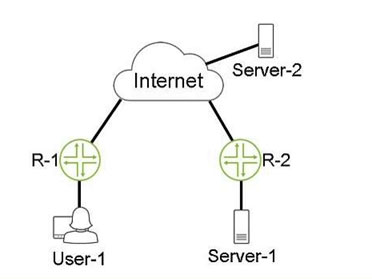Juniper JN0-362 Exam Practice Questions (P. 2)
- Full Access (64 questions)
- Six months of Premium Access
- Access to one million comments
- Seamless ChatGPT Integration
- Ability to download PDF files
- Anki Flashcard files for revision
- No Captcha & No AdSense
- Advanced Exam Configuration
Question #6
Which two statements are true for GRE tunneling? (Choose two.)
- AGRE tunnel endpoints must have a valid route to the remote endpointMost Voted
- BGRE tunnels support multiple logical units per interfaceMost Voted
- CGRE tunnels are stateful by default
- DGRE tunnels support only one logical unit per interface
Correct Answer:
AB
Reference:
https://www.juniper.net/documentation/en_US/junos/topics/topic-map/filtering-unicast-packets-multicast-tunnel-interfaces.html#id-configuring-unicast- tunnels
AB
Reference:
https://www.juniper.net/documentation/en_US/junos/topics/topic-map/filtering-unicast-packets-multicast-tunnel-interfaces.html#id-configuring-unicast- tunnels
send
light_mode
delete
Question #7
Click the Exhibit button.

Referring to the exhibit, the GRE tunnel between R-1 and R-2 allows connectivity between User-1 and Server-1. When User-1 communicates with Server-2 with packets that are 1472 bytes in size, no packet fragmentation occurs. User-1 can communicate with Server-1 with packets that are up to 1448 bytes in size with no packet fragmentation. However, if the packet size is larger than 1448 bytes, packet fragmentation occurs.
Why is the packet fragmentation occurring between User-1 and Server-1 in this scenario?

Referring to the exhibit, the GRE tunnel between R-1 and R-2 allows connectivity between User-1 and Server-1. When User-1 communicates with Server-2 with packets that are 1472 bytes in size, no packet fragmentation occurs. User-1 can communicate with Server-1 with packets that are up to 1448 bytes in size with no packet fragmentation. However, if the packet size is larger than 1448 bytes, packet fragmentation occurs.
Why is the packet fragmentation occurring between User-1 and Server-1 in this scenario?
- AThe GRE header adds 20 bytes to the packet
- BThe GRE header adds 24 bytes to the packetMost Voted
- CThe IP header adds 20 bytes to the packet
- DThe IP header adds 24 bytes to the packet
Correct Answer:
B
B
send
light_mode
delete
Question #8
What happens when a packet matches a static route with the next hop parameter set to reject?
- AThe system silently drops the packet
- BAn ICMP message is sent to the source and the packet is forwarded
- CAn ICMP message is sent to the source and the packet is droppedMost Voted
- DThe packet is forwarded and the packet is marked as rejected in the header
Correct Answer:
C
Reference:
https://www.informit.com/articles/article.aspx?p=30666&seqNum=5
C
Reference:
https://www.informit.com/articles/article.aspx?p=30666&seqNum=5
send
light_mode
delete
Question #9
Which two statements are correct about the BGP MED attribute? (Choose two.)
- ABGP uses the MED value when peering to two or more connections to the same upstream ASMost Voted
- BBGP routes require the MED attribute be defined
- CBGP uses the MED value when peering to two different upstream ASs
- DBGP assumes the MED value to be 0, if not already definedMost Voted
Correct Answer:
AD
Reference:
https://www.juniper.net/documentation/en_US/junos/topics/topic-map/med-attribute.html
AD
Reference:
https://www.juniper.net/documentation/en_US/junos/topics/topic-map/med-attribute.html
send
light_mode
delete
Question #10
What is the Junos default router priority advertisement value for IS-IS?
- A64Most Voted
- B32
- C0
- D127
Correct Answer:
A
Reference:
https://www.juniper.net/documentation/en_US/junos/topics/concept/routing-protocol-is-is-security-designated-router-understanding.html#:~:text=If%
20routers%20in%20the%20network,a%20priority%20value%20of%2064
.
A
Reference:
https://www.juniper.net/documentation/en_US/junos/topics/concept/routing-protocol-is-is-security-designated-router-understanding.html#:~:text=If%
20routers%20in%20the%20network,a%20priority%20value%20of%2064
.
send
light_mode
delete
All Pages
